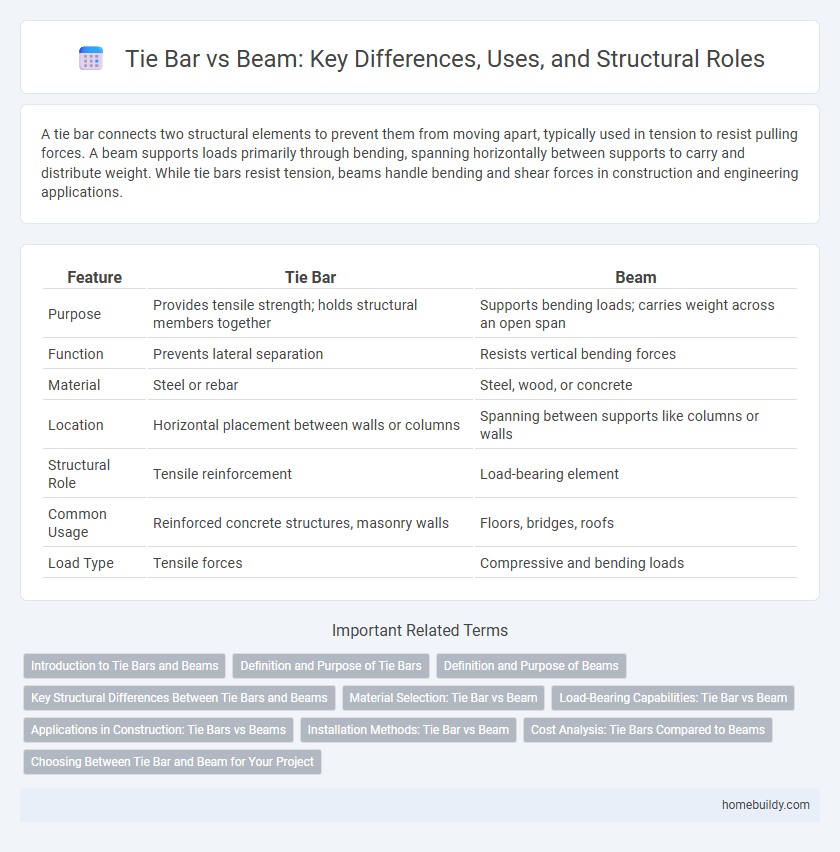A tie bar connects two structural elements to prevent them from moving apart, typically used in tension to resist pulling forces. A beam supports loads primarily through bending, spanning horizontally between supports to carry and distribute weight. While tie bars resist tension, beams handle bending and shear forces in construction and engineering applications.
Table of Comparison
| Feature | Tie Bar | Beam |
|---|---|---|
| Purpose | Provides tensile strength; holds structural members together | Supports bending loads; carries weight across an open span |
| Function | Prevents lateral separation | Resists vertical bending forces |
| Material | Steel or rebar | Steel, wood, or concrete |
| Location | Horizontal placement between walls or columns | Spanning between supports like columns or walls |
| Structural Role | Tensile reinforcement | Load-bearing element |
| Common Usage | Reinforced concrete structures, masonry walls | Floors, bridges, roofs |
| Load Type | Tensile forces | Compressive and bending loads |
Introduction to Tie Bars and Beams
Tie bars serve as reinforcement elements primarily used to hold structural components together, preventing separation under tension. Beams function as horizontal structural members designed to support loads by bending, transferring weight to columns or walls. Understanding the distinct roles of tie bars and beams is essential for effective structural design and load distribution.
Definition and Purpose of Tie Bars
Tie bars are short, straight steel components used primarily to hold two concrete slabs together, ensuring structural integrity and reducing differential movement, while beams are longer structural elements designed to support loads over a span. The primary purpose of tie bars is to transfer load across joints and prevent cracking in concrete pavements, whereas beams distribute loads to columns or walls and resist bending forces. Tie bars serve as load transfer units in slabs, promoting uniform stress distribution, unlike beams which act as the main horizontal carriers in building frameworks.
Definition and Purpose of Beams
Beams are structural elements designed to support loads primarily by bending, spanning horizontally between supports to carry vertical forces and transfer them to columns or walls. A tie bar, in contrast, is a tension member used to resist tensile forces, preventing components from separating under load. While beams serve as primary load-bearing members, tie bars provide lateral stability and tensile reinforcement in structural systems.
Key Structural Differences Between Tie Bars and Beams
Tie bars primarily function to resist tensile forces and provide lateral support, whereas beams are designed to carry bending loads and transfer vertical forces to supports. Tie bars are typically slender, tension members connecting columns or walls, while beams possess a larger cross-sectional area to withstand bending moments and shear stresses. The structural behavior of tie bars involves axial tension, contrasting with beams that experience combined bending and shear, influencing their respective design and material requirements.
Material Selection: Tie Bar vs Beam
Tie bars typically use high-strength steel alloys for their tensile properties and durability, whereas beams often incorporate structural steel or reinforced concrete optimized for compressive and bending loads. Material selection for tie bars prioritizes ductility and fatigue resistance to handle tension forces, while beam materials focus on stiffness and compressive strength to support vertical loads. Differences in mechanical properties and environmental exposure inform the choice between steel grades for tie bars and the concrete mix design or steel sections for beams.
Load-Bearing Capabilities: Tie Bar vs Beam
Tie bars provide enhanced tensile strength by resisting lateral forces and preventing structural movement, making them ideal for load stabilization in concrete slabs. Beams primarily support vertical loads through bending and shear, effectively distributing weight across longer spans in frameworks. Comparing load-bearing capabilities, tie bars excel in tension and lateral reinforcement, while beams deliver superior strength under compressive and bending stresses.
Applications in Construction: Tie Bars vs Beams
Tie bars and beams serve distinct roles in construction, with tie bars primarily used to reinforce concrete and provide tensile strength in slabs, walls, and foundations, preventing cracking and structural failure. Beams function as primary load-bearing elements, supporting vertical loads and transferring them to columns or walls, essential in framing floors, roofs, and bridges. The choice between tie bars and beams depends on structural requirements, where tie bars enhance tensile reinforcement within concrete elements, and beams act as main structural supports for overall stability and load distribution.
Installation Methods: Tie Bar vs Beam
Tie bars are installed by embedding them directly into concrete joints, using mechanical anchoring or epoxy bonding to ensure structural integrity and control cracking. Beams require more complex installation involving formwork, casting, and support during curing, often requiring cranes or heavy equipment for positioning and alignment. The simpler installation method of tie bars reduces labor and time compared to the more intricate and equipment-dependent process of beam erection.
Cost Analysis: Tie Bars Compared to Beams
Tie bars generally offer a more cost-effective solution compared to beams due to lower material and installation expenses. The simplified design of tie bars reduces labor time and minimizes the need for heavy equipment, resulting in significant savings. In contrast, beams often require more complex fabrication and support structures, increasing overall project costs.
Choosing Between Tie Bar and Beam for Your Project
Choosing between a tie bar and a beam depends on the structural requirements and load distribution of your project. Tie bars are ideal for tension reinforcement and preventing lateral movement, while beams provide robust support for bending and shear forces across longer spans. Evaluating factors like load type, span length, and installation complexity ensures the most efficient structural solution for durability and safety.
Tie bar vs Beam Infographic

 homebuildy.com
homebuildy.com